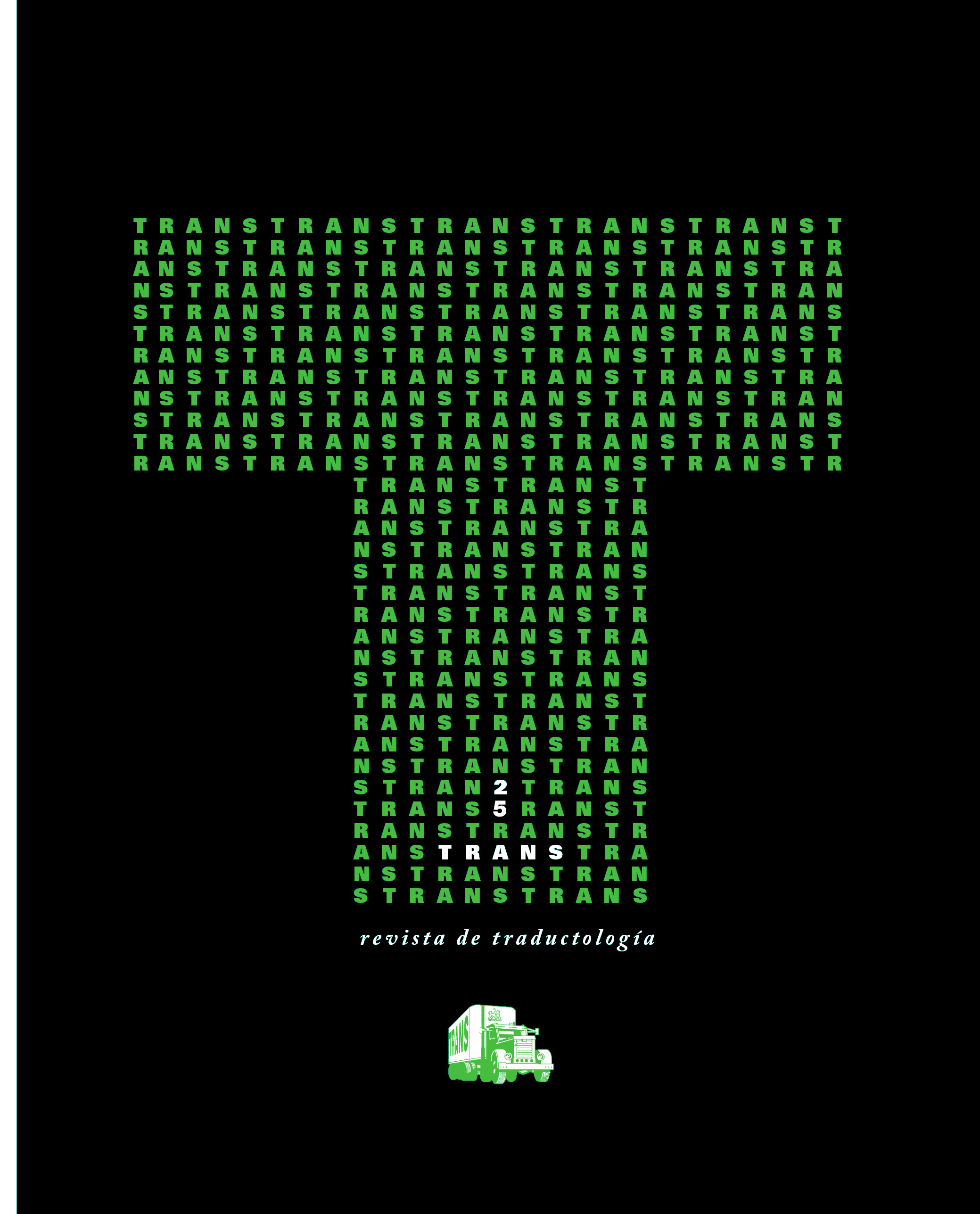Diatopic Varieties of Spanish and Neutral Spanish in Pharmaceutical Translations: an academic reflection from a professional perspective
DOI:
https://doi.org/10.24310/TRANS.2021.v1i25.11741Keywords:
pharmaceutical translation, diatopic varieties of Spanish, neutral Spanish, peninsular Spanish, Hispanic-American Spanish, Latin-American SpanishAbstract
The characteristics and the industry of pharmaceutical translations force translators to face the dilemma of which diatopic variety to use when translating. The daily practice of pharmaceutical translators often requires them to translate to varieties other than their native tongue, mainly to peninsular Spanish, Latin-American/Hispanic-American Spanish or neutral Spanish, as well as to other local varieties in Hispanic America. This paper aims at carrying out an academic reflection on the use of Spanish varieties in translation assignments of pharmaceutical texts, with particular emphasis on neutral Spanish, based on the author’s professional experience.
Downloads
Metrics
Publication Facts
Reviewer profiles N/A
Author statements
Indexed in
-
—
- Academic society
- N/A
- Publisher
- Universidad de Málaga
References
AEMPS (2010): «Presentación de traducciones de prospectos y fichas técnicas a la AEMPS: Indicaciones para su presentación y procedimiento para resolver traducciones pendientes», Agencia Española de Medicamentos y Productos Sanitarios – AEMPS, <https://www.aemps.gob.es/informa/notasInformativas/industria/2010/traduccion-Prospectos-FT.htm>.
AEMPS (2016): «Guía para la correcta traducción de textos y elaboración de maquetas de medicamentos veterinarios», Agencia Española de Medicamentos y Productos Sanitarios – AEMPS, <https://www.aemps.gob.es/industria/regMedicamentos/docs/guia_maqueta.pdf?x54046>.
A. NAVARRO, Fernando (2020): «Medical device», en Fernando A. NAVARRO (ed.), Diccionario de dudas y dificultades de traducción del inglés médico (3.ª edición), España: Cosnautas.
CABRÉ, María Teresa (2004): «Lenguajes especializados o lenguajes para propósitos específicos», Foro hispánico, 26, 19-23.
CABRÉ, María Teresa y R. Estopà (2005): «Unidades de conocimiento especializado: caracterización y tipología», en M. T. Cabré y C. Bach (eds.), Coneixement, llenguatge i discurs especialitzat, Barcelona: IULA, Documenta Universitaria, 69-95.
CASTRO, Xosé (2017): «El español neutro en la traducción», Blog @xosecastro, <http://xcastro.com/2017/10/05/espanol-neutro-traduccion/».
CID-LEAL, Pilar; María Carmen Espín-García & Marisa Presas (2019): «Traducción automática y posedición: Perfiles y competencias en los programas de formación de traductores», en Miguel TOLOSA IGUALADA y Álvaro ECHEVERRI (eds.): Porque algo tiene que cambiar. La formación de traductores e intérpretes: Presente & future. Because something should change: Present & Future Training of Translators and Interpreters. MonTI, 11, 187-214.
EDQM (2021): «Standard Terms», European Directorate for the Quality of Medicines & Healthcare, <https://standardterms.edqm.eu/>.
EMA (2021a): «Product-information templates – Human», European Medicines Agency. Science Medicines Health, <https://www.ema.europa.eu/en/human-regulatory/marketing-authorisation/product-information/product-information-templates-human>.
EMA (2021b): «EudraVigilance system overview», European Medicines Agency. Science Medicines Health, <https://www.ema.europa.eu/en/human-regulatory/research-development/pharmacovigilance/eudravigilance/eudravigilance-system-overview>.
FERNÁNDEZ-ORDOÑEZ, Inés (2016): «Dialectos del español peninsular», Javier GUTIÉRREZ REXACH (ed.), Enciclopedia de Lingüística Hispánica, Reino Unido: Routledge.
FUNDEU (2011): «Hispanoamérica, Iberoamérica y Latinoamérica no son sinónimos», Fundéu - RAE, <https://www.fundeu.es/recomendacion/hispanoamerica-iberoamerica-latinoamerica/#:~:text=Su%20gentilicio%20es%20latinoamericano.,habla%20portuguesa%2C%20el%20t%C3%A9rmino%20Iberoam%C3%A9rica>.
GARCÍA IZQUIERDO, Isabel (2006a): «El español neutro y la traducción de los lenguajes de especialidad», Sendebar, 17, 149-167.
GARCÍA IZQUIERDO, Isabel (2006b): «Neutral Spanish, Spanglish and Medical Translation. A case of heterodoxy», Translation Journal, 10 (3), <https://translationjournal.net/journal/37neutro.htm>.
GARGATAGLI, Marietta (2012): «La traducción neutra no es una pipa», Blog Ciudad de las Ideas, <http://ciudadideas.blogspot.com/2012/10/la-traduccion-neutra-no-es-una-pipa.html>.
GÓMEZ FONT, A. (2012): «Español neutro, global, general, estándar o internacional», Ómnibus, 39.
ICH (2020): «Members & Observers», ICH, <https://www.ich.org/page/members-observers>.
LA PRENSA (2010): «Los hispanohablantes de América prefieren el gentilicio “latinoamericano”, según encuesta», La Prensa, <https://www.laprensa.com.ni/2010/05/25/internacionales/25668-los-hispanohablantes-de-america-prefieren-el-gentilicio-latinoamericano-segun-encuesta>.
MARCILLY, R. et al. (2020): «How to interact with medical terminologies? Formative usability evaluations comparing three approaches for supporting the use of MedDRA by pharmacovigilance specialists», BMC Medical Informatics and Decision Making, 20 (1), 261-275, <https://zaguan.unizar.es/record/96111?ln=es>.
RAE (2005): «Diccionario panhispánico de dudas», Real Academia Española, <https://www.rae.es/dpd/>.
RED EAMI (n. d.): «Directorio de autoridades», Red de Autoridades en Medicamentos de Iberoamérica, <https://www.redeami.net/web/eami/seccion/contenedor_secciones/eami_conten_directorio_de_autoridades.htm>.
RODRÍGUEZ-PERDOMO, Tenesor (2012): «Promotor o patrocinador: las apariencias importan», Panace@, 13 (36), 346.
SÁENZ, Miguel (2013): «Traducir literatura al español, pero ¿a qué español?», Dieciocho conferencias nada magistrales y dos discursos de circunstancias, en Miguel SÁENZ (ed.), España: Ediciones Universidad de Salamanca, 81-92.
SOCA, Ricardo (2010): «¿Hispanoamericanos o latinoamericanos?», elcastellano.org, <https://www.elcastellano.org/%C2%BFhispanoamericanos-o-latinoamericanos>.
VILLALBA, Gabriela (2017): «Representaciones sobre el español en la traducción editorial argentina: metodología de una investigación», El taco en la brea, 5, 380-407.
ZARO VERA, Juan Jesús (2013): «La traducción, “zona de conflicto” entre España y la América hispana», Revista Debats, 121, 74-83.
Downloads
Published
How to Cite
Issue
Section
License
All contents published in TRANS. Revista de Traductología are protected under the Creative Commons Attribution-NonCommercial-ShareAlike 4.0 International (CC BY-NC-SA 4.0) license. All about this license is available in the following link: <http://creativecommons.org/licenses/by-nc-sa/4.0>
Users can copy, use, redistribute, share and exhibit publicly as long as:
- The original source and authorship of the material are cited (Journal, Publisher and URL of the work).
- It is not used for comercial purposes.
- The existence of the license and its especifications are mentioned.
- ShareAlike — If you remix, transform, or build upon the material, you must distribute your contributions under the same license as the original.
There are two sets of authors’ rights: moral and property rights. Moral rights are perpetual prerogatives, unrenounceable, not-transferable, unalienable, imprescriptible and inembargable. According to authors’ rights legislation, TRANS. Revista de Traductología recognizes and respects authors moral rights, as well as the ownership of property rights, which will be transferred to University of Malaga in open access.
The property rights are referred to the benefits that are gained by the use or the dissemination of works. TRANS. Revista de Traductología is published in an open access form and it is exclusively licenced by any means for doing or authorising distribution, dissemination, reproduction, , adaptation, translation or arrangement of works.
Authors are responsable for obtaining the necessary permission to use copyrighted images.













21.png)
